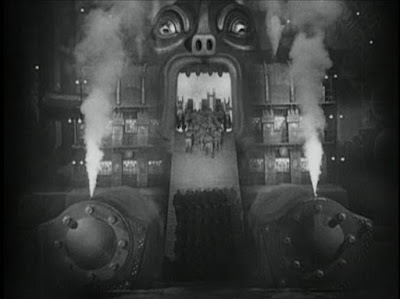The Mark of Zorro (1920)
Director Fred Niblo’s adaptation of Johnston McCulley’s story “The Curse of
Capistrano” captivates, thanks to brisk pacing and a spirited performance by Douglas
Fairbanks as the titular hero. Fairbanks stars as Don Diego Vega, who leads a
dual life as a pampered son of a wealthy 19th century California
aristocrat, and a hero of the people. His bland, sleepy countenance belies the
soul of a fighter. When he puts on his mask and outfit, he becomes Zorro, a
champion of the weak and downtrodden. He always stays one step ahead of the oppressive
governor (George Periolat), leaving his mark (a customary “Z”) wherever he goes.
The film’s formula has been emulated many times over the years, and has
frequently been cited as one of the inspirations for the Batman comic. Marguerite De La Motte is fine as Zorro’s main
squeeze, Lolita Pulido, who refuses to be a stereotypical damsel in distress. Filled
with action, thrills and the requisite modicum of romance, this movie was made
for popcorn.
Rating: ****. Available on DVD
Man with a Movie
Camera (aka: Chelovek S Kinoapparatom) (1929) Director Dziga Vertov’s (his
birth name was David Abelevich Kaufman) dizzying pastiche of images chronicles
life in the Soviet Union. The film isn’t presented as a conventional narrative,
and his fly-on-the wall, patchwork-quilt style prefigures such documentaries as
Koyaanisqatsi (1982) and Samsara (2012) by several decades. Instead, Vertov
lets the scenes play without comment, as the audience sees citizens at work and
play, and the various sequences cover the gamut from birth to death. Scenes of
hard labor in a coal mine and foundry are contrasted with frolicking on a beach.
Michael Nyman’s modern, frenetic score (featured on the Kino DVD) provides a
fitting accompaniment to the collage of activity.
Rating: ****. Available on DVD
Frankenstein (1910)
Thomas Edison’s production of Mary Shelley’s venerable story stars Augustus
Phillips as the eponymous creator, and Charles Ogle as his doomed creation. The
film covers a lot of ground in 14 minutes, taking quite a few liberties with
the source material along the way. For starters, the monster is brought to life
through alchemy, not stitched together from corpses. It’s a mesmerizing scene
nonetheless, as he comes into being via a cauldron of fire. Fans of Shelley’s
story will likely cry foul, especially when it comes to Frankenstein’s
responsibility (or lack thereof in this version) to his creation, or the
contrived happy ending, but it’s tough to deny the film’s significance for
cinephiles and horror fans alike.
Rating: ***½. Available on YouTube
Battling Butler (1926)
Compared to some of Buster Keaton’s better known flicks, the gags aren’t flying
as fast or furious, but what Battling Butler lacks in innovation, it makes up
in story. The key plot point is a case of mistaken identity between Alfred
Butler (Keaton), a milquetoast, spoiled rich kid, and prize fighter Alfred
“Battling” Butler (Francis McDonald). In order to keep the girl of his dreams
(Sally O’Neil, credited as “The Mountain Girl”), he must keep up the ruse of being
a professional boxer. The gags are somewhat hit and miss (pun unintended). It’s
hard to find a joke about spousal abuse funny, but there are some amusing bits throughout.
His misguided version of “roughing it” in the wilderness, with butler in tow,
provides some of the best scenes. The final shot of the film is memorable as
well. While Keaton is excellent as always, the real standout is Snitz Edwards,
in a terrific understated performance as his eager-to-please valet.
Rating: ***½. Available on DVD
It (1927) Clara
Bow stars as the original “It” girl, Betty Lou, in the movie that launched a
thousand rom-coms (based on a story by Elinor Glyn, who appears in a cameo). Betty
Lou is a lowly department store clerk who schemes to steal the heart of the
store’s wealthy owner Cyrus T. Waltham (Antonio Moreno). It’s an enjoyable romp
on the surface, and Bow is suitably cute and charming, but the implications
about a woman’s worth in the early 20th century are disturbing. According
to the film’s central thesis, the world’s your oyster as long as you’re young,
pretty and childless (her single mom roommate doesn’t fare very well).
Admittedly, I’m not part of the film’s target audience, so the wish fulfillment
elements didn’t do much for me. If you know what you’re getting into, and (like
most sane people) take the film at face value, It serves its purpose.
Rating: ***. Available on DVD
A Fool There Was
(1915) This is the movie that introduced the world to the vampire (or “vamp”
for short) – not the supernatural being, but a bloodsucker, nonetheless. Theda
Bara plays The Vampire, a predatory woman who leaves a trail of broken men in
her wake. The story focuses on her efforts to entrap a poor, defenseless
diplomat into an affair, while his family idly stands by. A Fool There Was is best remembered for Bara’s performance as a
borderline sociopath, which is better than the production deserved. It’s worth
seeing for its place in film history, but should be regarded as a curio, due to
its dim view of female sexuality and women who dare to climb the social ladder.
Rating: **. Available on DVD.




























